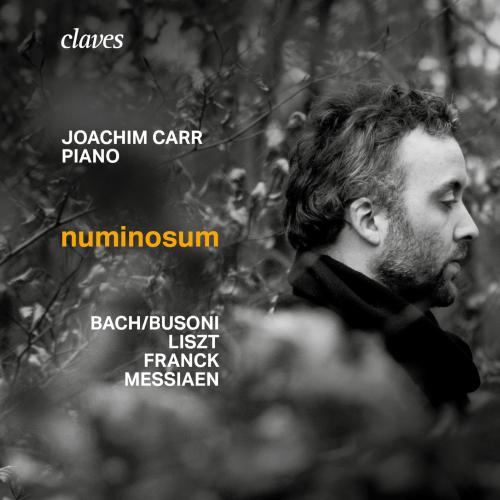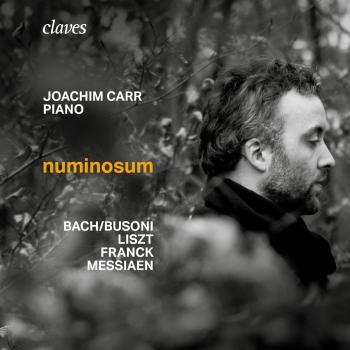
Numinosum: Works by Bach-Busoni, Liszt, Franck & Messiaen Joachim Carr
Album Info
Album Veröffentlichung:
2023
HRA-Veröffentlichung:
07.07.2023
Label: Claves Records
Genre: Classical
Subgenre: Instrumental
Interpret: Joachim Carr
Komponist: Johann Sebastian Bach (1685-1750), Ferruccio Busoni (1866–1924), Franz Liszt (1811-1886), Cesar Franck (1822-1890), Olivier Messiaen (1908-1992)
Das Album enthält Albumcover Booklet (PDF)
- Johann Sebastian Bach (1685 - 1750): Chorale Preludes: Ich ruf’ zu dir, Herr Jesu Christ, BWV 639 (Transcr. by Ferruccio Busoni, BV B 27):
- 1 Bach: Chorale Preludes: Ich ruf’ zu dir, Herr Jesu Christ, BWV 639 (Transcr. by Ferruccio Busoni, BV B 27) 03:45
- Franz Liszt (1811 - 1886): Deux légendes, S. 175:
- 2 Liszt: Deux légendes, S. 175: I. St. François d'Assise: la prédication aux oiseaux 10:42
- Johann Sebastian Bach: Chorale Preludes:
- 3 Bach: Chorale Preludes : Nun komm’ der Heiden Heiland, BWV 659 (Transcr. by Ferruccio Busoni, BV B 27) 05:06
- Olivier Messiaen (1908 - 1992): Vingt Regards sur l'Enfant Jésus:
- 4 Messiaen: Vingt Regards sur l'Enfant Jésus: V. Regard du Fils sur le Fils 08:38
- Johann Sebastian Bach: Chorale Preludes:
- 5 Bach: Chorale Preludes: Wachet auf, ruft uns die Stimme, BWV 645 (Transcr. by Ferruccio Busoni, BV B 27) 03:03
- Franz Liszt: Deux légendes, S. 175:
- 6 Liszt: Deux légendes, S. 175: II. St. François de Paule marchant sur les flots 07:53
- Johann Sebastian Bach: Chorale Preludes: Komm, Gott Schöpfer, Heiliger Geist, BWV 667 (Transcr. by Ferruccio Busoni, BV B 27):
- 7 Bach: Chorale Preludes: Komm, Gott Schöpfer, Heiliger Geist, BWV 667 (Transcr. by Ferruccio Busoni, BV B 27) 02:04
- Olivier Messiaen: Vingt Regards sur l'Enfant Jésus:
- 8 Messiaen: Vingt Regards sur l'Enfant Jésus: XIV. Regard des Anges 05:25
- César Franck (1822 - 1890): Prelude, choral et fugue, FWV 21:
- 9 Franck: Prelude, choral et fugue, FWV 21: I. Prelude. Moderato 05:03
- 10 Franck: Prelude, choral et fugue, FWV 21: II. Choral. Poco più lento - Poco allegro 06:47
- 11 Franck: Prelude, choral et fugue, FWV 21: III. Fugue. Tempo I° 07:45
Info zu Numinosum: Works by Bach-Busoni, Liszt, Franck & Messiaen
This album features works by composers for whom the conception and creation of music was intimately bound up with a religious attitude towards the world. Before the birth of aesthetics in the 18th century, the symbolic or “external” meanings of music resided in the music itself; neither its expressiveness nor its purpose as an integral part of social and religious rituals were separated from a larger context of moral and spiritual considerations. In this sense, although their tonal languages and forms differ greatly, later composers such as Liszt, Franck and Messiaen followed the spirit of Bach, reflecting a musical philosophy in which musical means and theological ends were deeply intertwined, if not one and the same.
What impact does a greater awareness of the symbolic realities of religious thought, which inspired the music in the first place, have on how we — the interpreter and the listener — hear the music, and what meanings we find within it? In the accompanying essay on the following pages, I offer some observations about the program and about art more generally from a philosophical and metaphysical perspective. I propose that the experience of art — which, like the religious experience, is an encounter with the world and the inexplicable — has the potential of challenging the boundaries between self and other.
In those instances where the pull towards something other is of such magnitude that it renders the self utterly powerless and will-less, we are in the presence of the numinosum. The numinous quality resides in the phenomenon itself and is a dynamic force that takes hold of and acts upon the subject. The word derives from the Latin numen, meaning ‘divine power’ or ‘spirit’, and was coined by Rudolf Otto in his book Das Heilige, which explores the non-rational elements underpinning personal belief, and the role that spontaneous, immediate experiences play in this respect. In its adjective form, the numinous evokes the words luminous and ominous; it hints at both emanating light and at the overwhelming sense of the unknown.
The recording of the album took place in the winter of 2020 in a church on the remote Lofoten Islands in Northern Norway. During the so-called mørketid — literally “dark-time” or dark season — the light which illuminates the skies from below the horizon for only a few hours a day holds a greater meaning. This atmosphere was, I believe, very appropriate to this particular music, and certainly had an impact on the sessions. In the North, the sense that light acquires its significance from its absence or negation is more visceral. If darkness is the great unknown, something without properties and beyond measurement, its meta-physical presence is often what inspires the more immediate qualities of experience. And as illumination stands forth in contrast with the obscure, it is also within the unknown that possibility and becoming lie. (Joachim Carr)
Joachim Carr, piano
Joachim Carr
The Norwegian pianist Joachim Carr has over the last few years established himself as one the most exciting musicians to emerge from Scandinavia. The past season's highlight saw him performing the Grieg A minor Concerto with the Bergen Philharmonic under John Storgårds at the closing concert of the Bergen International Festival.
He has won several international prizes, including the First Prize, the Audience Award as well as the Orchestra's Prize of the Bergen Philharmonic at the International Edvard Grieg Piano Competition in 2014. The same year he also won the First Prize at the International Chamber Music Competition in Lyon with his regular violin partner, Diana Tishchenko. Previously, he had received the coup de coeur Special Prize for his recital at the Concours Clara Haskil in 2013, and the Boris Pergamenschikow Prize for contemporary chamber music in Berlin with his Trio Korngold. Following his traditional debut recital at the Oslo University Aula in 2015, he received the Robert Levin Prize.
He has performed with the Royal Stockholm Philharmonic, the Lithuanian State Symphony, the Trondheim Symphony, the Ålesund Symphony, and the Norwegian Radio Orchestra, collaborating with conductors Alexander Vedernikov, Gintaras Rinkevicius, Miguel Harth-Bedoya, Leo McFall, Eivind Aadland and Bjarte Engeset.
A versatile chamber musician and recitalist, he has been invited to festivals such as the Klavierfestival Ruhr, Zermatt Festival, Bergen International Festival, Lofoten Piano Festival, Cully Classique, Bach Festival Moscow, Festspiele Mecklenburg-Vorpommern and Salzburger Kammermusikfestival with chamber music partners including Antje Weithaas, Andrei Ionita, Ingrid Fliter, Bertrand Chamayou, Henri Demarquette and Arve Tellefsen.
Born 1988 in Bergen, important musical impulses in his youth came from pianists Jan Henrik Kayser, Håvard Gimse and Leif Ove Andsnes. After studies at the Barratt Due Institute of Music in Oslo with Czech pedagogue Jiri Hlinka, he moved to Berlin and continued his postgraduate studies with Eldar Nebolsin at the Hochschule für Musik "Hanns Eisler". In later years he has also received invaluable advice from Rita Wagner and Ferenc Rados.
Of his debut album, released in 2014 on Claves and featuring early works by Schumann, Brahms and Berg, Diapason wrote: “these performances place him amongst the most promising pianists of his generation”. For the Naxos Grand Piano label he is currently in the process of recording piano concertos by the forgotten composer Halfdan Cleve with the Norwegian Radio Orchestra.
Due for release in 2018 is a duo recording with violinist Diana Tishchenko with works by Debussy, Janáček and Prokofiev for the Betont label and a guest performance in Liszt's Hungarian Phantasy with the Royal Norwegian Navy Band as part of Naxos' complete Percy Grainger series.
Booklet für Numinosum: Works by Bach-Busoni, Liszt, Franck & Messiaen










